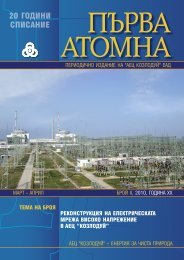Summary Report for Conduct of Kozloduy NPP Stress Tests
Summary Report for Conduct of Kozloduy NPP Stress Tests
Summary Report for Conduct of Kozloduy NPP Stress Tests
You also want an ePaper? Increase the reach of your titles
YUMPU automatically turns print PDFs into web optimized ePapers that Google loves.
“<strong>Kozloduy</strong> <strong>NPP</strong>” PLC<br />
SUMMARY REPORT<br />
<strong>for</strong> <strong>Conduct</strong> <strong>of</strong> <strong>Kozloduy</strong> <strong>NPP</strong><br />
<strong>Stress</strong> <strong>Tests</strong><br />
<strong>of</strong> water intake from the pumps <strong>of</strong> service water system <strong>for</strong> cooling <strong>of</strong> safety system consumers <strong>of</strong><br />
units 3 and 4.<br />
In addition, analysis was conducted <strong>for</strong> beyond design basis accident with complete loss <strong>of</strong><br />
water in the SFP due to beyond design basis earthquake, at which ground stability is affected and<br />
significant cracks open in the rein<strong>for</strong>ced concrete <strong>of</strong> the SFP.<br />
Drainage <strong>of</strong> fuel storage compartments at existing condition <strong>of</strong> SFS and simultaneous failure<br />
to all systems and unavailability <strong>of</strong> natural ventilation will bring to significant increase in<br />
temperature <strong>of</strong> fuel elements (to 600°С) and <strong>of</strong> the civil structure (up to 340°С), which is not<br />
permissible from the point <strong>of</strong> view <strong>of</strong> safety margins <strong>for</strong> safe SNF storage but will not result in fuel<br />
melting [113].<br />
Analysis <strong>of</strong> events with complete loss <strong>of</strong> power supply cover also events with complete loss<br />
<strong>of</strong> cooling <strong>of</strong> the SFP (loss <strong>of</strong> ultimate heat sink).<br />
5.4.4 Measures to improve robustness <strong>of</strong> SFS to loss <strong>of</strong> ultimate heat sink<br />
In relation with SFS, no measures are proposed to enhance robustness to loss <strong>of</strong> ultimate<br />
heat sink.<br />
5.5 CONCLUSION<br />
A reassessment <strong>of</strong> the safety margins <strong>of</strong> the nuclear installations at the <strong>Kozloduy</strong> site is<br />
per<strong>for</strong>med <strong>for</strong> the events with consequent loss <strong>of</strong> safety functions that would lead to a severe<br />
accident. The scope includes the nuclear reactors and the spent fuel pools <strong>of</strong> units 5 and 6, the spent<br />
fuel pools <strong>of</strong> units 3 and 4 and the spent fuel storage facility. The reassessment is based on safety<br />
analysis per<strong>for</strong>med with deterministic approach.<br />
The results <strong>of</strong> the analysis <strong>of</strong> postulated initiating events with loss <strong>of</strong> power and loss <strong>of</strong><br />
ultimate heat sink show in general strong robustness <strong>of</strong> the provisions and adequate time period <strong>for</strong><br />
implementation <strong>of</strong> additional recovery actions. Specifically, the results imply that:<br />
· Due to the low value <strong>of</strong> residual heat loss <strong>of</strong> electrical power and/or ultimate heat<br />
sink in SFP does not lead to severe damage to the fuel, including total loss <strong>of</strong> water in the<br />
storage pool;<br />
· The low value <strong>of</strong> residual heat in SFP-3 and SFP-4 provides sufficient time <strong>for</strong><br />
recovery <strong>of</strong> failed safety functions (6.8 days <strong>for</strong> SFP-3 and 9.2 days <strong>for</strong> SFP-4);<br />
· Most vulnerable are Units 5 and 6 and their fuel storage pools:<br />
During power operations and in cold state but with pressurized primary circuit the reactors<br />
are the most robust against loss <strong>of</strong> power and ultimate heat sink because:<br />
· The residual heat from the core can be removed to the secondary circuit. The<br />
ultimate heat sink is air (steam discharge from safety or relief valves <strong>of</strong> SG) ;<br />
159/202

















